

| Administrator Guide > Security and Permissions > Users |
The System User functionality is used to create and maintain Temenos users for the organization. The Users page can be accessed from System Management > Users, and displays all users for the organization.
 |
The default view of this page is the All Users view, which lists all users in alphabetical order by username. |

The following columns display in the Users page:
| Column Name | Description |
| Username | Displays the user name of the user. |
| Name | Displays the full name (Last, First) of the user. |
| Active | If checked, the user is active in Temenos Infinity. |
| Logged In | If checked, the user is currently logged into Temenos Infinity. |
| Last Login | Displays when the date and time of when the user was last logged in. |
From the Users page, administrators can perform the following actions:
The following attributes are defined within the User Edit window when creating or editing a Temenos user:
The User Information tab provides system administrators with the ability to define specific information for the user, such as the username and authentication credentials.

This tab includes the following three sections:
The User Information section allows system administrators to enter basic information about the user.
 |
Certain fields within this section can be included within letter and email templates. |
The following fields display within the User Information section:
| Field Name | Description | ||
| First Name | Enter the first name of the user. This is a required field. | ||
| Last Name | Enter the last name of the user. This is a required field. | ||
| Username | Define a username for the user. This is used to log into Temenos Infinity, if not using Windows Authentication. This is a required field. | ||
| Enter in the user’s email address. This is a required field. | |||
| Description | If necessary, enter in a description for the user. | ||
| User Type | Define the role of the user within Temenos Infinity from this drop-down. This correlates to the workflow history colors under System Management > Administrative Settings. The security for the user is not determined by this drop-down. | ||
| Time Zone | Define the time zone for the user. This reflects the time that displays in a workflow history screen when an account is worked. | ||
| Active | Select this check box to activate the user. Leave the check box blank to deactivate a user. | ||
| Logged In |
If checked, this box indicates whether the user is logged into Temenos Infinity.
|
||
| Phone | Enter in the phone number of the user. | ||
| Phone Extension | Enter in the phone extension of the user. | ||
| Branch | If there are multiple branches, select the branch where the user works. This is system-defined. | ||
| Department | Enter the name of the user's department. | ||
| Title | Enter the job title of the user. |
 |
While this topic has been updated to reflect the new Temenos Infinity branding, Lifecycle Management Suite will continue to appear for this section until such a time that the branding can be updated. |
Within the Lifecycle Management Suite Authentication section, define the sign-in method of the new user.
By default, System is selected, which requires the user to enter in username and password to sign into Temenos Infinity. The administrator must define the password in this section.
 |
The value of the password is masked upon entry in the Password and Confirm Password fields.
|
Select the Windows method to allow users to sign in using the  button on the sign-in page. If this option is selected, the system validates the Windows ID and password for the user during the log in process. Enter the Windows Account for the user in the Windows Account field. The format for the windows account is always DOMAIN NAME\username.
button on the sign-in page. If this option is selected, the system validates the Windows ID and password for the user during the log in process. Enter the Windows Account for the user in the Windows Account field. The format for the windows account is always DOMAIN NAME\username.

Select the Public API method to establish a dedicated user to communicate with connectors and third party integrations using the Public API DMZ service.
 |
These settings are only used for certain connectors that utilize the Public API DMZ service. |

Upon selecting this method, complete the following parameters:
| Parameter | Description | ||||||
| API Key |
Enter the API Key generated by Temenos. This field is required.
|
||||||
| Secret Key |
Enter the Secret Key generated by the financial institution. This parameter provides an added level of security to financial institutions.
|
Select the SAML SSO method to allow users to sign in using the ![]() button on the sign-in page. If this option is selected, the system redirects to the configured SAML SSO provider's page to validate the credentials for the user during the log in process. Enter the NameID provided by the SAML SSO identity provider for the user in the SAML NameID field.
button on the sign-in page. If this option is selected, the system redirects to the configured SAML SSO provider's page to validate the credentials for the user during the log in process. Enter the NameID provided by the SAML SSO identity provider for the user in the SAML NameID field.

Within the Host Authentication section, define the Host ID, Host ID 2, and Host Password for the host system.
 |
These settings are only used for certain host systems. For more information, please see the applicable core connector guide for the institution. |

The Company Information tab is comprised of two sections: Company Information and Organization Structure.
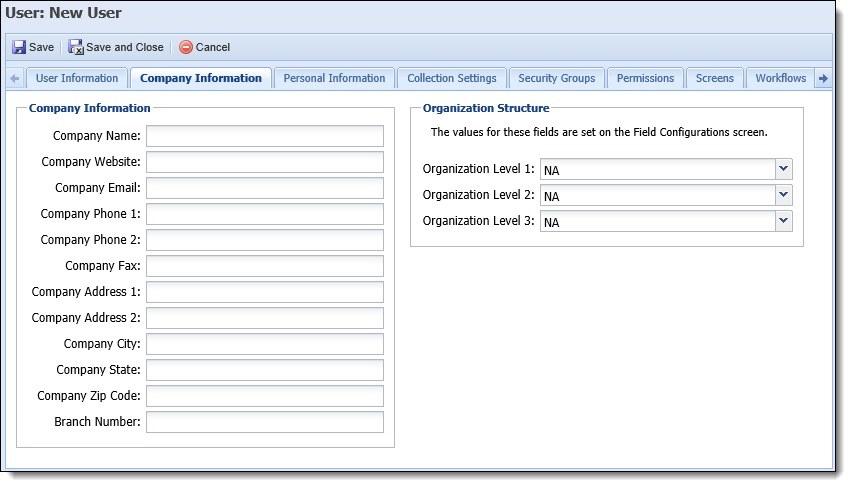
The Company Information section of the tab provides the ability to define the following information for the user:
 |
The fields within the Company Information section are for informational purposes only. |
| Field Name | Description |
| Company Name | Enter the name of the company. |
| Company Website | Enter the website URL for the company. |
| Company Email | Enter the email address for the company. |
| Company Phone 1 | Enter in the primary phone number for the company. |
| Company Phone 2 | Enter an additional phone number in which the company can be reached. |
| Company Fax | Enter in a fax number for the company. |
| Company Address 1 | Enter the first line of the company address. |
| Company Address 2 | Enter in the second line of the company address. |
| Company City | Enter the city in which the company is located. |
| Company State | Enter the state in which the company is located. |
| Company Zip Code | Enter the zip code in which the company is located. |
| Branch Number | Enter the branch number of the company. |
Within the Organization Structure section, select a value from the desired Organization Level field(s) to define how the user is to be grouped for easier reporting purposes. The values in each drop-down populate from the ORG_LEVEL1, ORG_LEVEL2, or ORG_LEVEL3 lookup fields in System Management > Field Configurations.
The Personal Information tab provides system administrators with the ability to define the user’s personal information.
 |
The fields within the Personal Information section are for informational purposes only. |

The following fields display in this tab:
| Field Name | Description |
| Address 1 | Enter the first line of the user’s home address. |
| Address 2 | Enter the second line of the user’s home address. |
| City | Enter the city in which the user resides. |
| State | Enter the state in which the user resides. |
| Zip Code | Enter the Zip Code in which the user resides. |
| Home Phone | Enter the home phone number of the user. |
| Other Phone | Enter an additional phone number of the user. |
| Home Email | Enter in the personal email address of the user. |
The Collections Settings tab provides the ability to set collection standards for the user. These fields are used by administrators to track collection performance.
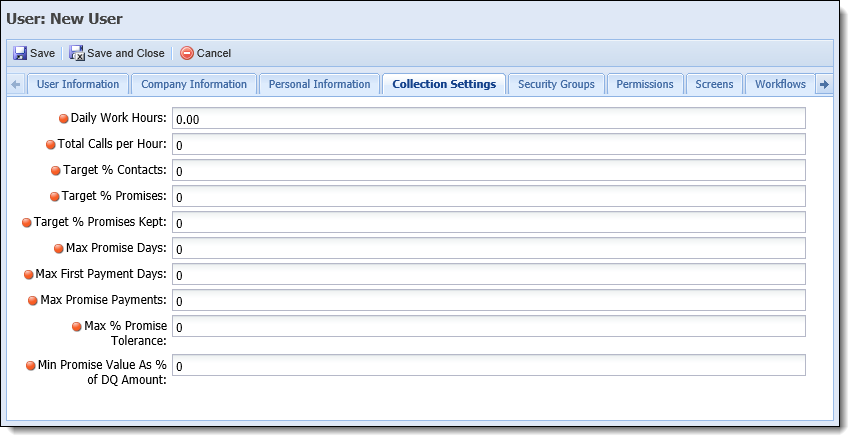
The following fields display within this tab:
| Field Name | Description | How contributes to User Performance | ||
| Daily Work Hours | Identifies the number of hours per a day that the user is expected to work. | N/A | ||
| Total Calls per Hour | Identifies the number of calls that a collector is expected to make per hour. |
Used to determine:
|
||
| Target % Contacts | Identifies the percentage of calls placed by the user expected to result in a successful, valid contact. |
Used to determine:
|
||
| Target % Promises | Define the percentage of successful promises the user must meet. |
Used to determine:
|
||
| Target % Promises Kept | Define the percentage of successful promises kept the user must meet. |
Used to determine:
|
||
| Max Promise Days | Identifies the maximum number of days a collector can define for the time period in which the total promise must be fulfilled. For example, if the max promise days is set to 30 days and the user sets the promise to be completed in 45 days, the promise goes to management for approval. |
N/A | ||
| Max First Payment Days | Identifies the maximum number of days in advance that a collector can schedule the first promise payment. For example, if the max first payment days is set to 10 days and the user schedules the first payment in 20 days, the promise goes to management for approval. |
N/A | ||
| Max promise payments |
Identifies the maximum number of payments in which a user is able to divide a promise payment.
For example, if the max promise days in System Management > Modules > Collection is equal to 4, and the user sets up 5 payments, the promise is deferred to management approval. |
N/A | ||
| Max % Promise Tolerance |
Identifies the maximum percentage of the total promise amount that a user can accept to satisfy the promise payment. A promise payment can be short without being considered broken as long as the payment meets the discount requirement specified here.
|
N/A | ||
| Min Promise Value As % of DQ Amount |
Identifies the minimum % of the total promise amount that the user is allowed to accept. |
N/A |
 |
For additional information on User Performance, please see the User Performance Web Part topic in the User Guide. |
Within the Security Groups tab, assign the user to a Security Group. The Security Groups available to assign are defined in System Management > Groups > Security Groups.
 |
A user can be assigned to multiple security groups. |
The Permissions tab enables system administrators to manage a user’s access to several features throughout the system.
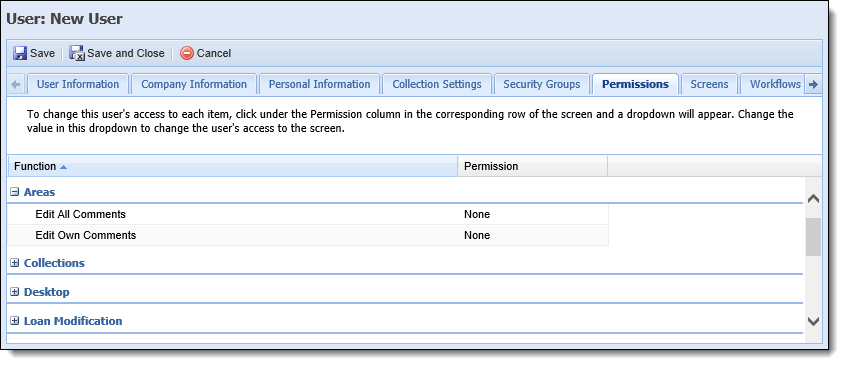
This tab contains two columns: Function and Permission. Click under the Permission column in the corresponding row, and a drop-down appears. Change the value in this drop-down to modify the user's access to the functionality.
The following permission options are available for each user:
Reference the following section for an overview of each permission table:
The tables below provide a list of the permissions available under each category, as well as a description of each permission.
| Application Processing - Loan | |||
| Name of Permission | Description | ||
|
Add and Delete Fees on Application:
Allows a user to add and remove fees that have been automatically or manually added to a loan application. |
None = Add and Delete buttons are disabled in the Fees panel. Edit is disabled for the Fees grid.
Change = Add and Delete buttons are enabled in the Fees panel. Edit is enabled for the Fees grid. |
||
|
Approve Loan:
Allows a user to manually approve an application. |
None = "Approve" button is disabled in the Workflow and Application Toolbar.
Change = "Approve" button is enabled in the Workflow and Application Toolbar if Status <> Incomplete, Disbursed or Not Eligible. |
||
|
Change Applicants Receiving Adverse Action Notice:
Allows user to change the field to send an adverse action notice to a particular applicant from the Reject Application & Withdraw Application windows. |
None = applicant check boxes are disabled on Reject Application and Withdraw Application windows.
Change = applicant check boxes are enabled on Reject Application and Withdraw Application windows. |
||
|
Change Effective Date on Application:
Allows a user to update the Effective Date field on the application screen that collects loan term information. |
None = user does not have permission to override and is presented with an override pop-up window if the field has been modified.
Change = user has permission to override and is not presented with override pop-up if the field has been modified. Also allows user to input credentials into the override pop-up for other users. |
||
|
Change Fees from Sub-Product:
Allows a user to modify the amount of a fee automatically added to a loan application by the system. |
None = User does not have permission to override the amount for a loan fee, and is presented with an override pop-up window when a Fee field is modified.
Change = User has permission to override the fee amount for a loan fee, and is not presented with the override pop-up when an Fee field is modified. This permission also allows a user to input credentials into the override pop-up for other users. |
||
|
Change Introductory Term on Application:
Allows a user to manually change the introductory term that is used for Introductory Rate calculations. |
None = Introductory Term field is disabled on the Loan Terms screen.
Change = Introductory Term field is enabled on the Loan Terms field |
||
|
Change Variable Rates:
Allows a user to change the Variable Rate fields (listed below) on the Loan Terms screen.
|
None = user does not have permission to edit fields. If fields have been changed by the user they are presented with an override pop-up window.
Change = user has permission to edit fields and is not presented with override pop-up. Also allows user to input credentials into the override pop-up for other users. |
||
|
Change Vendor on Application:
Allows a user to change the Vendor/Dealer field during the application process. |
None = Vendor field is disabled in the Properties pop-up box when Dealer Purchase or Indirect are selected as Source.
Change = Vendor field is enabled in the Properties pop-up box when Dealer Purchase or Indirect are selected as Source. |
||
|
Cross-sells In Loan Amount Exceed Approval Tolerance:
Allows a user to override the Approval Tolerance Amount that is set on the sub-product definition (only if it is exceeded because of cross-sells being included in the loan amount, such as GAP & MBC). |
None = user does not have permission to override and is presented with an override pop-up window.
Change = user has permission to override and is not presented with override pop-up. Also allows user to input credentials into the override pop-up for other users. |
||
|
Decline Loan:
Allows a user to decline a loan application. |
None = "Decline" button is disabled in the Application Toolbar and Workflow.
Change = "Decline" button is enabled in the Application Toolbar and Workflow if Status <> Incomplete, Disbursed, or Not Eligible. |
||
|
Disburse Loan:
Allows a user to Disburse and book the loan to the core system. |
None = The Disburse button is not able to be selected in the Application Toolbar and Workflow.
Change = The Disburse button able to be selected in the Application Toolbar and Workflow. |
||
|
Edit Adverse Action Reasons:
Allows a user to add Reject & Adverse Action Reasons to an application via the Other Actions button. |
None = "Collect Adverse Actions" is disabled in the Other Actions dropdown.
Change = "Collect Adverse Actions" value in the Other Actions dropdown list is active and can be selected. |
||
|
Edit Disbursement Date:
Allows a user to edit the Disbursement Date field. |
None = Disbursement Date is disabled on the application screen that collects loan term information.
Change = Disbursement Date field is enabled on the application screen that collects loan term information. |
||
|
Edit Doc Stamps Program:
Allows a user to edit fields in the application related to the Doc Stamps Program. |
None = User does not have permission to edit fields.
Change = User has permission to edit fields. |
||
|
Edit First Notification, Second Notification and Expiration Dates:
Allows a user to edit these fields on the Loan Terms screen. |
None = User does not have permission to edit fields.
Change = User has permission to edit fields. |
||
|
Exclude Payee from OFAC:
Allows a user to exclude a check payee from being checked via the OFAC interface during the Disbursement. |
None = "Do Not Run OFAC" Checkbox is disabled on Edit Payee OFAC Information window.
Change = "Do Not Run OFAC" Checkbox is enabled on Edit Payee OFAC Information window. |
||
|
Fund Delay Reasons - Add:
Allows a user to add a Fund Delay Reason and Delay Extensions to the application. |
None = Add button is disabled in the Fund Delay panel and Create & Edit Delay screen
Change = Add Button is enabled in the Fund Delay panel and Create & Edit Delay screen. |
||
|
Fund Delay Reasons - Delete:
Allows a user to remove a Fund Delay Reason or Delay Extension on the application. |
None = Delete button is disabled in the Fund Delay panel and Create & Edit Delay screen.
Change = Delete button is enabled in the Fund Delay panel and Create & Edit Delay screen. |
||
|
Fund Delay Reasons - Edit:
Allows a user to modify a Fund Delay Reason and Delay Extension on the Application. |
None = Edit button is disabled in the Fund Delay panel and Create & Edit Delay screen.
Change = Edit is enabled in the Fund Delay panel and Create & Edit Delay screen. |
||
|
Fund Delay Reasons - Waive:
Allows a user to mark a delay as being waived in the Fund Delay. |
None = Waive checkbox is disabled in the Fund Delay panel and Create & Edit Delay screen.
Change = Waive checkbox is enabled in the Fund Delay and Create & Edit Delay screen. |
||
|
Initial Amount Exceeds Min/Max for Sub-Product:
Allows a user to override the Min/Max Amount values that are set at the sub-product definition. For example: New Auto has a min amount of $1500.00. An application is being submitted and the Requested Amount is $1000.00. An override box pops-up for users who do not have this permission and requires someone with this authority to put in their credentials in order for the user to proceed with the application. |
None = user does not have permission to override and is presented with an override pop-up window.
Change = user has permission to override and is not presented with override pop-up. Also allows user to input credentials into the override pop-up for other users. |
||
|
LO Approval – Display Adverse Actions:
Allows user to view/edit the Adverse Action panel on the Approve Application screen. |
None = Adverse Action sub-panel is not displayed on the Approve Application screen.
Change = Adverse Action sub-panel is displayed and editable on the Approve Application screen. |
||
|
Loan Covenants – Add:
Allows a user to add loan covenants to a loan application. |
None = Add button is disabled in the Loan Covenants panel.
Change = Add button is enabled in the Loan Covenants panel.
|
||
|
Loan Covenants – Change:
Allows a user to modify a loan covenant on a loan application.
|
None = The Edit button is disabled in the Loan Covenants panel, and the fields that support inline editability are read-only in the panel grid.
Change = The Edit button is enabled in the Loan Covenants panel, and inline editing is available for the applicable fields in the panel grid. |
||
|
Loan Covenants – Allow Delete:
Allows a user to remove loan covenants that have been automatically or manually added to the application. |
None = The Delete button is disabled in the Loan Covenants panel.
Change = The Delete button is enabled in the Loan Covenants panel. |
||
|
Loan Covenants - Waive on Application:
Allows a user to mark a loan covenant as waived on a loan application. |
None = Waive check box is disabled when editing a loan covenant in the Loan Covenants panel.
Change = Waive check box is enabled when loan covenant in the Loan Covenants panel. |
||
|
Loan Cross-sells Exceed Max Amount:
Allows a user to override the Max Loan Cross-Sell Amount (the sum of all an application’s new/replacement Cross-sell offers) that can be set by an underwriter on the manual underwriting screen. For example: An underwriter has set the Max Loan Cross-Sell amount to be $10,000.00 on the underwriting screen. The end user gets to the Cross-Sell screen and pitches the Cross-sell products. The applicant wants all the available cross-sell offers, which total $15,000.00. An override box appears for users who do not have this permission and requires someone with this authority to put in their credentials in order for the user to proceed with the application. |
None = user does not have permission to override and is presented with an override pop-up window.
Change = user has permission to override and is not presented with override pop-up. Also allows user to input credentials into the override pop-up for other users. |
||
|
LTV Exceeds Min/Max for Sub-Product:
Allows a user to override the Min/Max LTV value that is set at the sub-product definition. For example: New Auto has a max LTV of 110%. An application is being processed and the LTV is calculated to be 112%. An override box pops-up for users who do not have this permission and requires someone with this authority to put in their credentials in order for the user to proceed with the application. |
None = user does not have permission to override and is presented with an override pop-up window.
Change = user has permission to override and is not presented with override pop-up. Also allows user to input credentials into the override pop-up for other users. |
||
|
Recurring Fees - Add and Delete:
Allows a user to add recurring fess to a loan application, as well as remove recurring fees that have been automatically or manually added to the application. |
None = Add and Delete buttons are disabled in the Recurring Fees panel.
Change = Add and Delete buttons are enabled in the Recurring Fees panel. |
||
|
Recurring Fees - Change Recurring Fees:
Allows a user to modify a recurring fee on a loan application. |
None = Fields are read-only in the Recurring Fees panel, and cannot be modified.
Change = Inline editing is available in the Recurring Fees panel, and users are able to modify field values within the grid. |
||
|
Recurring Fees - Waive on Application:
Allows a user to mark a recurring fee as waived on a loan application. |
None = Waive check box is disabled when editing a fee in the Recurring Fees panel.
Change = Waive check box is enabled when editing a fee in the Recurring Fees panel. |
||
|
Unmask Lending Fields TIN and DOB:
Allows a user to view unmasked values for the TIN and Date of Birth fields in an application. |
None = User is unable to view an unmasked value of the TIN and Date of Birth fields in an application. When the user hovers over the
View = User is able to view the full unmasked value of the TIN and Date of Birth fields in an application. User can search using a partial (any length) TIN or full 9-digit TIN (formatted as either 999-99-9999 or 99-999999). |
||
|
Waive Loan Review Indicator:
Allows a user to mark a loan review indicator account as waived. |
None = The waived flag remains read-only on the Loan Review Indicator panel.
Change = The waived flag can be set to True for a given account on the Loan Review Indicator panel. |
||
| System Management | |
| Name of Permission | Description |
|
Administrative Settings:
Allows a user to view and change administrative settings within Temenos Infinity. Administrative Settings can be accessed in System Management and include settings such as look and feel, security and institutional information. |
None = Users can not view or access the Administrative Settings page in System Management.
View = Allows users to view but not make any changes to the Administrative Settings page in System Management. Change = Allows users to view and make changes within the Administrative Settings page in System Management. |
|
Configuration Export:
Allows a user to view, edit and change Configuration Manager Exports. |
None = Users can not view or access the Export Configurations page in System Management > Configurations.
View = Users can view the Export Configurations in System Management. Change = Allows users to view and make changes within the Export Configurations page in System Management > Configurations. |
|
Configuration Import:
Allows a user to view, edit and change Configuration Manager Imports. |
None = Users can not view or access the Import Configurations page in System Management > Configurations. View = Users can view the Import Configurations in System Management. Change = Allows users to view and make changes within the Import Configurations page in System Management > Configurations. |
| Data Purging Allows a user to view and change the data purge settings for Temenos database tables. |
None = Users can not view or access the Data Purging page in System Management > Data Purging.
View = Allows users to view, but not make any changes to the Data Purging page in System Management > Data Purging. Change = Allows users to view and make changes within the Data Purging page in System Management > Data Purging. |
|
Field List Configurations:
Allows a user to map values from the BANKRUPTCY_PARTY_TYPE and PARTY_TYPE lookups to up to 10 flattened Bankruptcy Party or Legal Party fields, in order to populate the data in letters, views, and/or reports.
|
None = Users cannot view or access the Field List Configurations page in System Management..
View = Allows users to view the Field List Configurations page in System Management, but not make any changes. Change = Allows users to view and make changes within the Field List Configurations page in System Management. |
|
GL Accounts (Recovery Module):
Allows a user to view and change GL Accounts when using the Recovery Module. GL Accounts are used when defining the posting rules on a transaction code to determine how a new transaction is allocated on a recovery account. |
None = Users can not view or access the GL Accounts page in System Management.
View = Allows users to view but not make any changes to the GL Accounts page in System Management. Change = Allows users to view and make changes within the GL Accounts page in System Management. |
|
Letter Barcode Activation:
Allows a user to activate the letter barcode process and define the location where scanned files are to be placed for the institution. |
None = Users can not view or access the Letter Barcode Activation page in System Management > Communication > Letter Barcode Activation.
View = Allows users to view, but not make any changes to the Letter Barcode Activation page in System. Change = Allows users to view and make changes within the Letter Barcode Activation page in System Management. |
|
Letter Barcode Scanning Exceptions:
Allows a user to view exception documents, as well as manually attach the documents to the applicable account or cases. |
None = Users can not view or access the Letter Barcode Scanning Exceptions page in System Management > Communication > Letter Barcode Scanning Exceptions.
View = Allows users to view, but not make any changes to the Letter Barcode Scanning Exceptions page in System. Change = Allows users to view and make changes within the Letter Barcode Scanning Exceptions page in System Management. |
|
Letters and Forms:
Allows a user to create letters and other forms to be used when working a case within the system.
|
None = Users can not view or access the Letters and Forms page in System Management > Communication > Letters and Forms.
View = Allows users to view but not make any changes to the Letters and Forms page in System Management > Communication > Letters and Forms. Change = Allows users to view and make changes within the Letters and Forms page in System Management > Communication > Letters and Forms. |
| Process Scheduling |
None = Users does not have access to view the new Processes System Management Screen.
|
|
Transaction Codes (Recovery Module):
Allows a user to track payments, adjustments, and expenses on charged off accounts. Multiple transaction codes can be configured to apply funds differently to an account. |
None = Users can not view or access the Transaction Codes page in System Management.
View = Allows users to view but not make any changes to the Transaction Codes page in System Management. Change = Allows users to view and make changes within the Transaction Codes page in System Management. |
Within the Screens tab, assign available screens to the user. If a screen is assigned, the user has access to the screen in the personworkspace.
 |
The screens and boxes that display on the User Edit screen are determined by the enabled module(s). For example, if origination is not active, origination screens are not available to be assigned, and the Available and Assigned Origination Screens boxes do not display on the Screens tab. If the institution uses the Account Servicing modules, as well as the Origination modules, boxes display to assign both Collection screens and Origination screens to the user. |
 |
If the security group the user is assigned to has access to the screen, by default the user has access to the screen even if they do not at the user level. |
In the Workflows tab, workflows can be assigned to “None,” “View,” or “View & Execute.”

If a workflow is assigned to None, the user is not able to view the workflow history associated to the workflow nor execute the workflow. If assigned to View, the user can view the workflow history associated to the workflow but cannot execute it. If assigned to View & Execute, the user can view the workflow history and execute the workflow on an account, case, or person.
 |
If the security group the user is assigned to has access to the workflow, the user has access to the workflow by default, even if he or she does not have access at the user level. |
In order for a user to have access to a workflow on an Area, the following criteria must be met:
For each Workflow, security can be set on the Area and the User or Security Group level. This security only applies when a user enters the Workspace of an Area. For example, if a workflow is not assigned to an Area, the workflow does not appear in the Area regardless of the security applied to the workflow.
When assigning a workflow to an Area or assigning Users and Security Groups to a workflow, there are three levels of security:
 |
None is the lowest level of security, and View & Execute is the highest level of security. |
In the Dashboards tab, assign available dashboards to the user. If assigned the user is able to open the dashboard from the dashboard icon in the Ribbon Bar.
 |
If the security group the user is assigned to has access to the dashboard, by default the user has access to the dashboard even if they do not at the user level. |
In the Views tab, assign available views to the user. If assigned, the user is able to open the view from the views icon in the Ribbon Bar.
 |
If the security group the user is assigned to has access to the view, by default the user has access to the view even if they do not at the user level. |
In the Reports tab, assign available reports to the user. If assigned, the user has the ability to view/run the reports from the reports icon in the Ribbon Bar.
 |
If the security group the user is assigned to has access to a report, the user has access to the report by default, even if he or she does not have access at the user level. |
In the Areas tab, assign available areas for the Account Servicing modules to the user. These assigned areas are available to the user in the Areas drop-down in the person workspace.
 |
If the security group the user is assigned to has access to the area, the user has access to the area by default, even if he or she does not have access at the user level. |
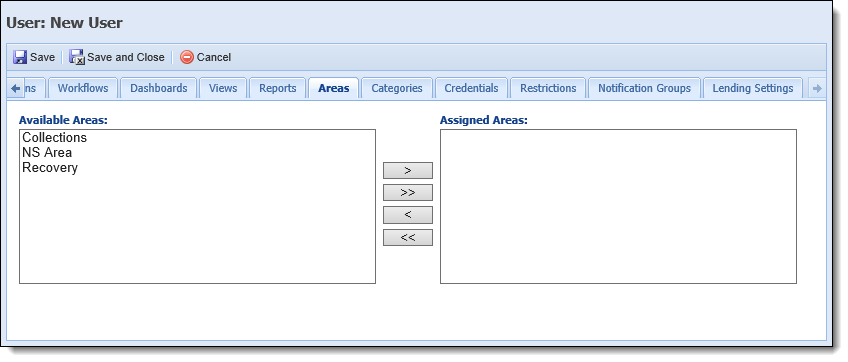
 |
This functionality is no longer used in Temenos Infinity, and will be removed from the User attributes in an upcoming product release. |
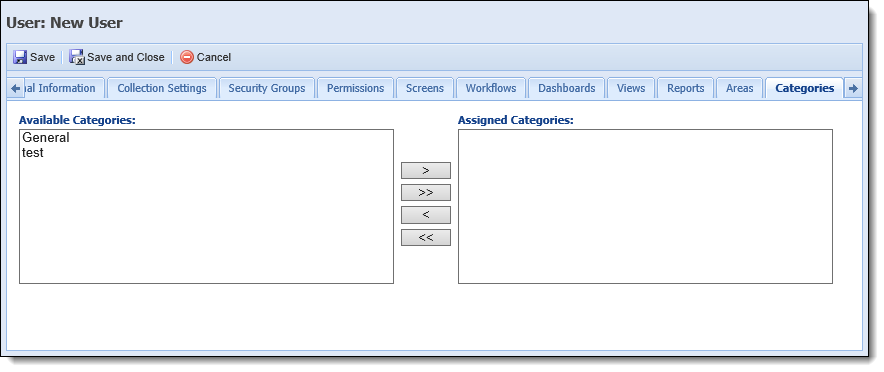
User Credentials enable administrators to assign the user specific IDs required for certain functionality throughout Temenos Infinity.
 |
Credentials may be used as a prerequisite when activating certain third party connectors within Temenos Infinity. For more information on whether credentials are required for a connector, refer to the applicable Connector Guide. |

Administrators can add and remove credentials for a user by means of the Credentials toolbar. Once a credential is added, the below attributes may be assigned in the grid displayed:
 |
If desired, the Connector Credentials Import Process can be manually run on demand from the server where Temenos Infinity is installed to import user level connector credentials from an Excel file, and automatically populate the credentials within the Credentials tab for each user in the file. Reference the Connector Credentials Import section below for more information on this functionality: The Connector Credentials Import process provides the ability to easily import third party credentials for all users with access to a connector's functionality, rather than separately adding credentials for each user within the Credentials tab. A system administrator or IT Support representative for the institution can manually run this process on demand from the server where Temenos Infinity is installed. The following section provides an overview of the steps to take to import connector credentials for each active user in Temenos Infinity:
Step One: Create and Export Report of Active UsersPrior to running the Connector Credentials Import process, system administrators can create a report from the Reports page in the Ribbon Bar that identifies the username for each active user in Temenos Infinity. The following fields can be added to the report within the Fields tab of the Report Configuration window to generate a list of the usernames:
Once created, the report can be run, and then exported to Excel.
After the Excel file is created, system administrators can save the file locally, and use it as a base to create the import file for the Connector Credentials Import process. Step Two: Create the Import File for the Credentials Import ProcessThe Excel file of active users can be used as a base to create the file for the Connector Credentials Import process. System administrators can export an Excel file with credentials from the applicable third party, and then add the credentials to the Excel file created with the user information from Temenos Infinity. Each file must include the following three columns of information, and a row for each active user having credentials imported for the connector:
Step Three: Run the Connector Credentials Import ProcessAfter the Import file has been created and saved for the connector, the LMS.Core.CredentialsImport exe file process can be manually run from the institution's server. To run this process:
Step Four: Review Log FileWhen the Connector Credentials Import process is run, a Log File is automatically created on the Share Path to provide an overview of the Import results for each Credential Type. The Log file for the Connector Credentials Import can be accessed by navigating to the share folder on the server where Temenos Infinity is installed, selecting the Log folder, and then opening the Connector Credentials Import file. This file contains a section for each credential type imported during the Connector Credentials Import process, including the date and time the import was run, as well as the following information about the results of the Import:
If a failure occurs, a separate "Failed" entry appears in the file for each record that failed to import for the credential type. This entry lists the number of the record that could not be imported, the LMS username associated with the failed record, the connector username associated with the failed record, and an error message that identifies the reason for the failure. Reference the table below for an overview of the error messages that may appear for a failed record in the Log File for the Connector Credentials Import:
|
| Field | Description | ||||
| Type |
Select the type of user credential being added for the user. Credentials may be system-defined, or specific to a connector. The following credentials are system-defined:
|
||||
| ID | Enter the ID, or username, assigned to the user for the third party connector. | ||||
| Password |
If a password is required, enter the user's password for the third party connector.
|
||||
| Confirm Password | If a password is required, re-enter the password defined in the Password field. |
Restriction Codes are used to identify accounts containing personal information for individuals employed by or related to a financial institution.
This section allows system administrators to restrict users from accessing specific accounts within Temenos Infinity. System administrators can assign codes to a user, which grant the user access to accounts that are restricted. Additionally, system administrators can prevent users from accessing a person's account by adding the person's identifier to the Restricted Persons grid.
 |
In order to view an account, the user must be granted permission based on both the Restriction Code and Restricted Persons. |

Account Restriction allows access to restricted accounts to be controlled on an account by account basis. Permissions are set on each user to give access to restricted accounts.
To enable Account Restriction in Temenos Infinity, select the "Enable Account and Person Restrictions" check box on the Security Tab in System Management > Administrative Settings.
The restriction level on an account is determined by the Temenos Account Restriction Code field. If Account Restriction Processing is enabled in Temenos Infinity, then a user must be given the appropriate permissions in order to view restricted accounts.
By default, all users have access to accounts with a 0 or no Account Restriction Code. To grant a user access to restricted accounts, enable access within the Restricted Account section by entering a value in each applicable Restriction Code field. The possible value for the Restricted Access field on each account are 0-6. The numeric values represent the following types of restricted accounts:
(0) Normal
(1) Restricted
(2) Sensitive
(3) Employee
(4) Employee Family
(5) Employee Sensitive
(6) Employee Sensitive Family
In order for a user to view an account with a Restricted Access level of 1 or higher, the user must have an Account Restriction Access of an equal or greater value. For example, if an account has a Restricted Access level of 3, then a user must have a 3, 4, 5, or 6 entered in the "Restriction Code 1" field in order to view the account.
System administrators can restrict persons from a user, which prevents that user from gaining access to the person’s account workspace. When a person is restricted, all of the person's related accounts and cases are also restricted. If the user tries to access a restricted person through a search, or when working a queue, a message appears stating that the person/account requires special permission to view.
 |
The system uses the following logic to populate accounts for restricted and non-restricted persons in the workspace:
|
To add a person restriction for a user:
 within the top of the Restricted Persons grid.
within the top of the Restricted Persons grid.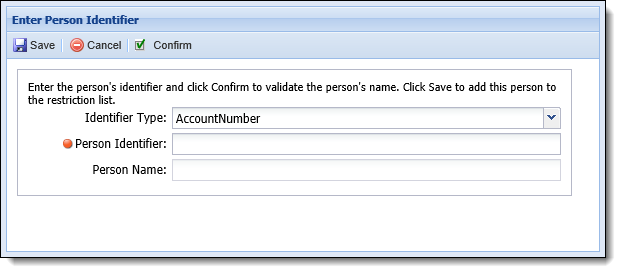
 .
. , the person’s name appears under the Person Identifier.
, the person’s name appears under the Person Identifier. . The Person Identifier is added to the grid.
. The Person Identifier is added to the grid.In the Notification Groups tab, assign available notification groups to the user. If assigned, the user has the ability to receive notifications when a comment is added to an application via email or from the Notifications icon in the ribbon bar.
 |
This tab is available for all users, but is only used to assign Notification Groups for use in the Origination modules. |
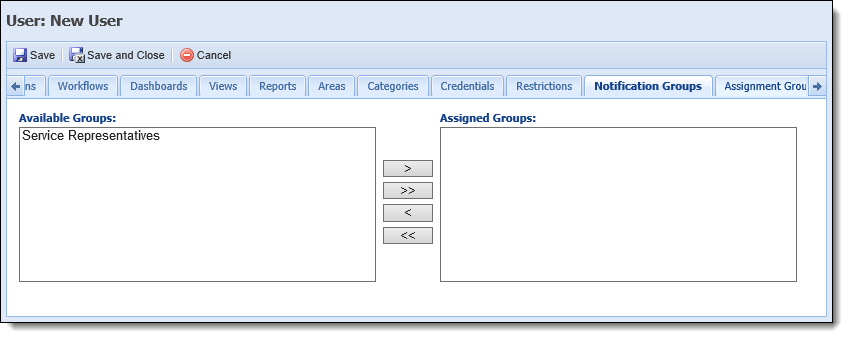
 |
This tab is available for all users, but is only used to assign Assignment Groups for use in the Origination modules. |
In the Assignment Groups tab, assign the user to the applicable Assignment Groups.
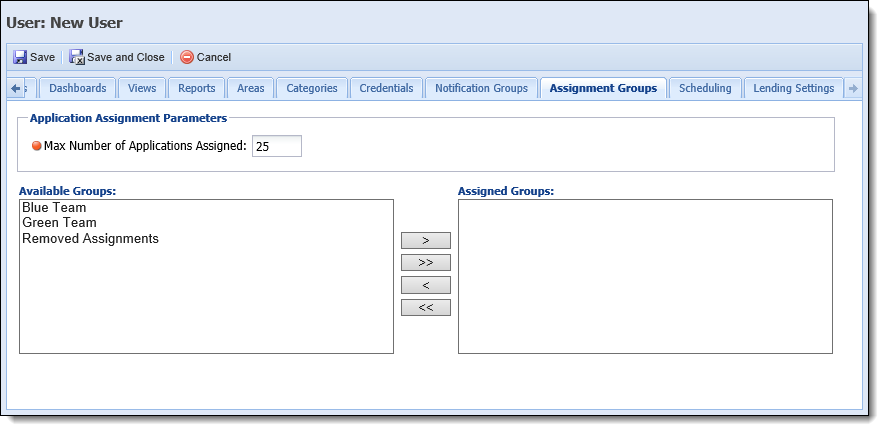
| Field | Description | ||||
| Max Number of Applications Assigned |
Enter the maximum number of applications that can be assigned to the user.
|
Assign available assignment groups to the user. If assigned, the user is able to have applications automatically assigned.
 |
For more information on Assignment groups, please see the Assignment Groups topic in this guide. |
The Scheduling tab enables administrators to identify a user’s scheduled time off, so that applications are not assigned to the user during a time that he or she is not available to work applications.
 |
This tab is available for all users, but is only used to set a schedule for users who work in the Origination modules. |
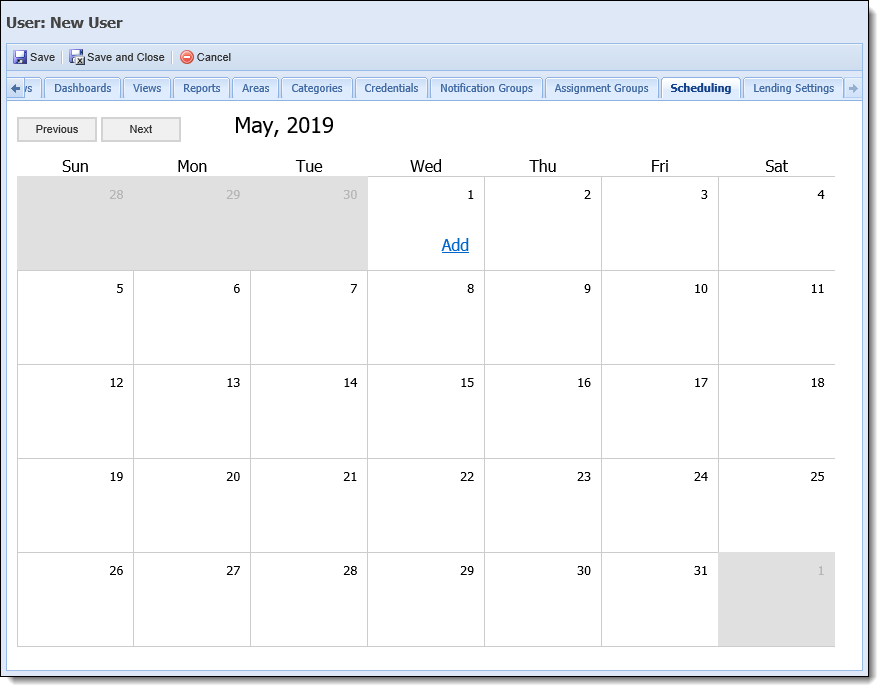
The Scheduling tab includes a calendar that displays the days and times that the user is not available to work applications.
At the top of the calendar, administrators are able to click  to go back to the previous month, and click
to go back to the previous month, and click  to advance to the next month.
to advance to the next month.
To establish a schedule, hover over the desired day, and click Add to open the Calendar pop-up window.
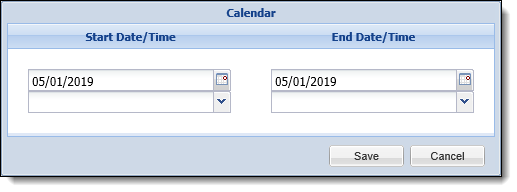
Within the Calendar window, use the Date/Time controls to set the user's schedule.
 |
Administrators are able to select a date range to set the schedule for multiple days at once. |
 to select the Start/End Time.
to select the Start/End Time.Once a schedule is set, the Start/End Time displays in the calendar within Scheduling tab.
Lending Settings enables administrators to assign Application Sources and Restricted Account Types to each user working in the Origination module.
 |
This tab is available for all users, but is only used to assign Lending Settings for the Origination modules. |
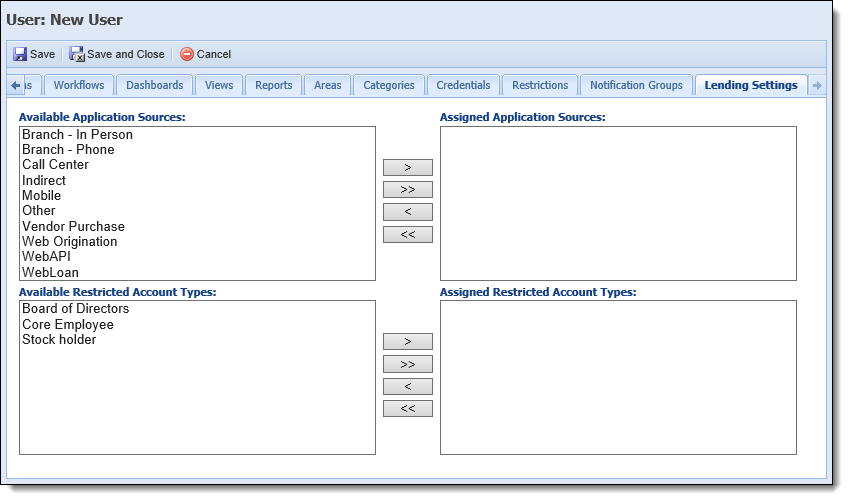
To create a user:
 . The New User screen appears.
. The New User screen appears. to retain the new user, and return to the Users page.
to retain the new user, and return to the Users page.To copy an existing user:
 .
. .
.To edit an existing user:
 .
. .
.When a user is deactivated, the Active check box on the General tab is disabled.
To unlock a user that has been deactivated, perform the following actions:
 .
. to retain the user settings.
to retain the user settings.To delete a user:
 .
.